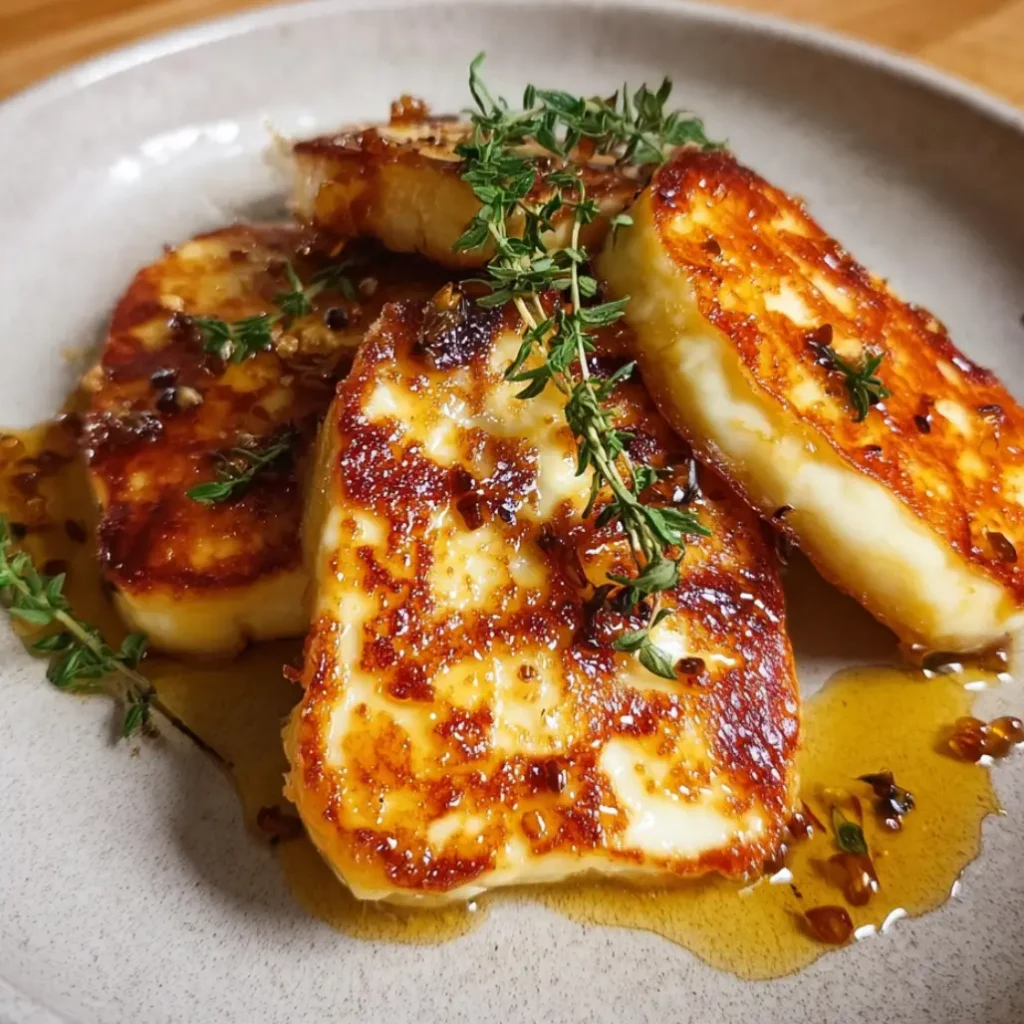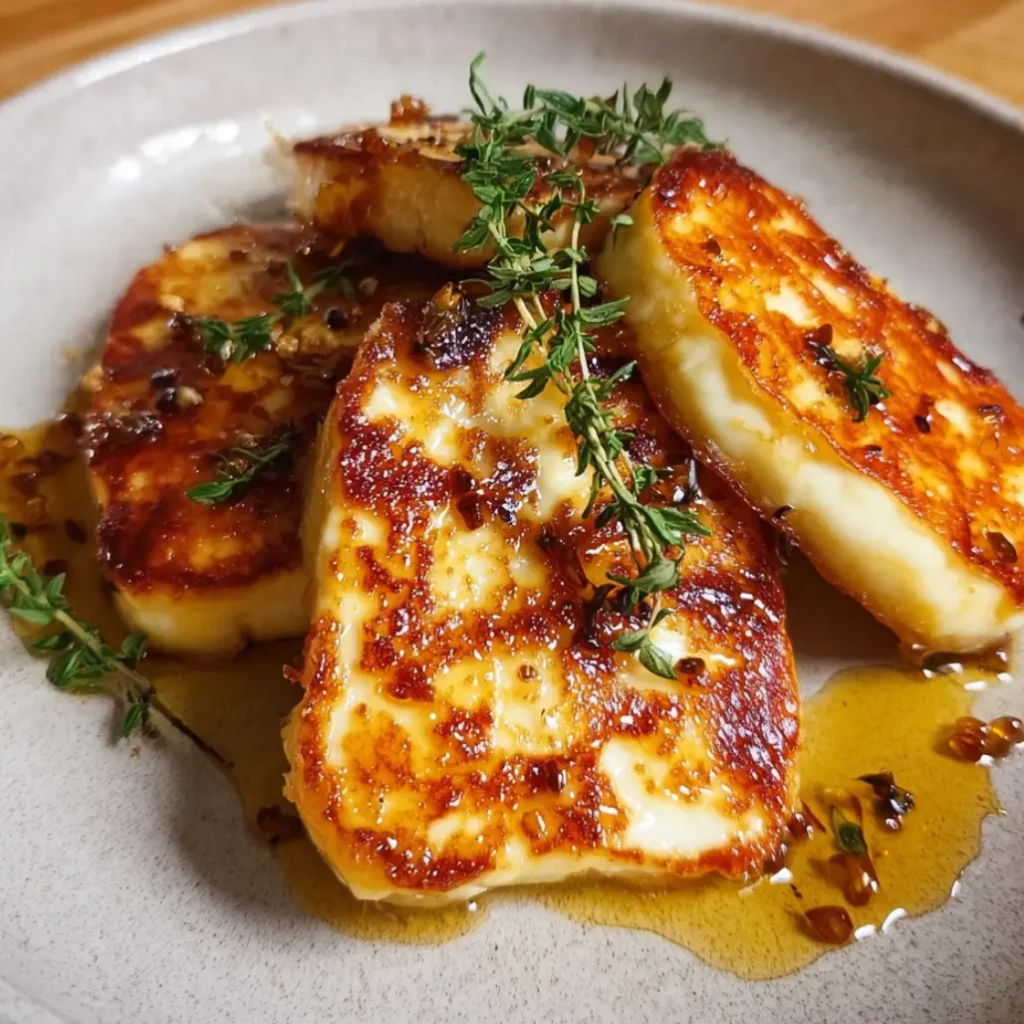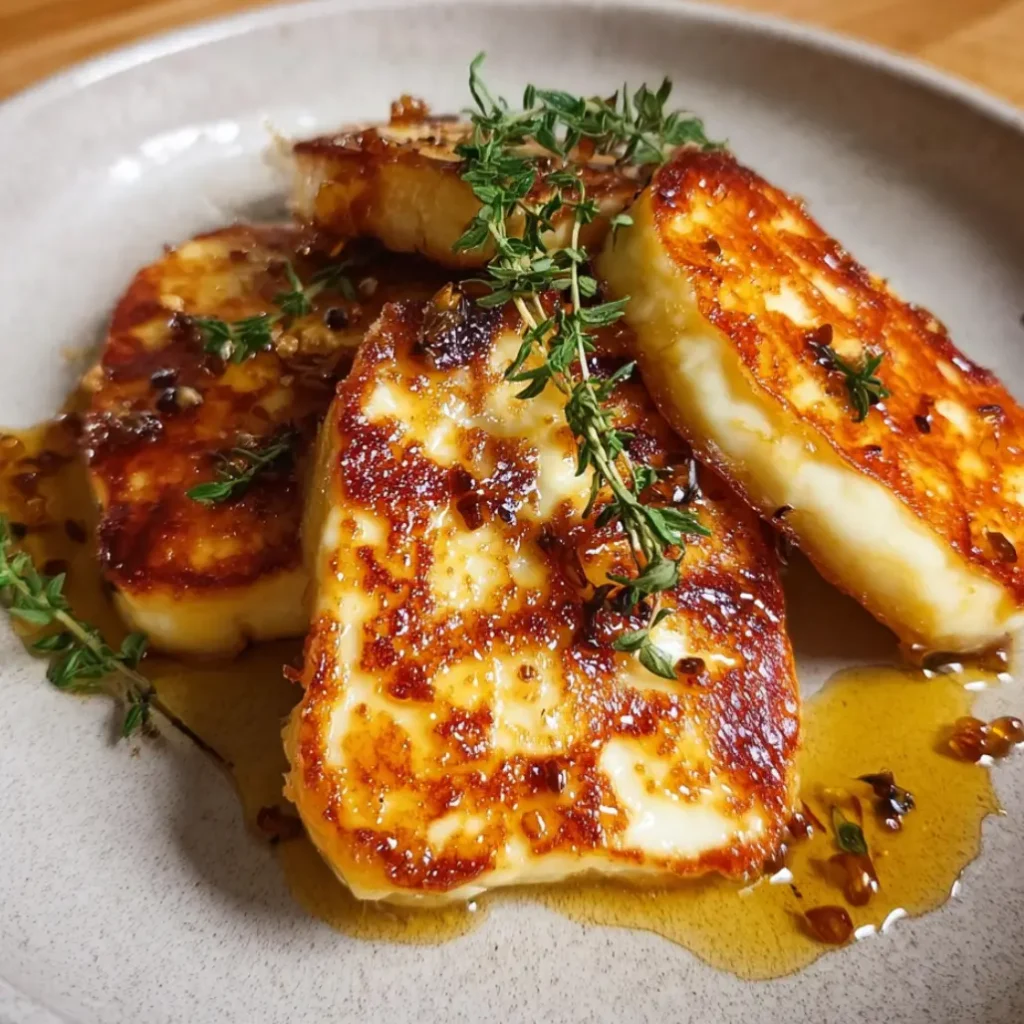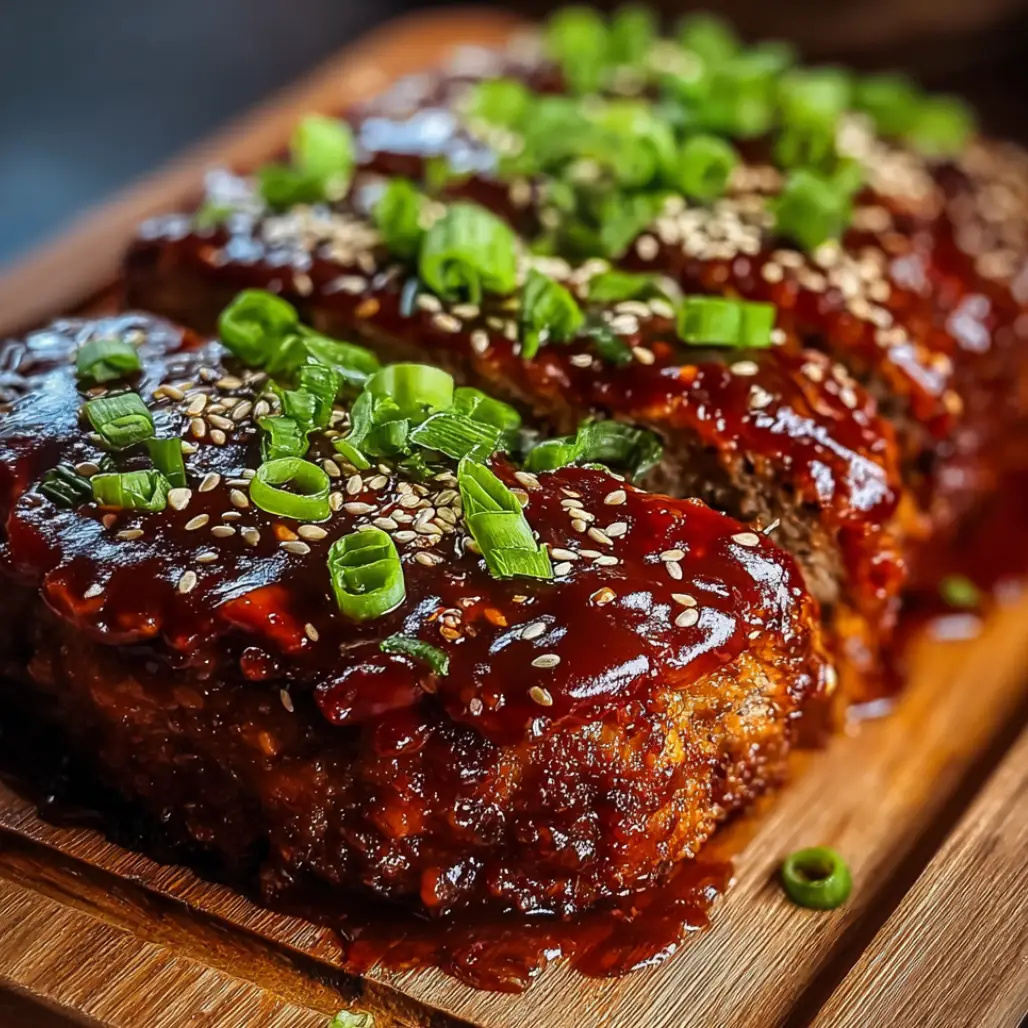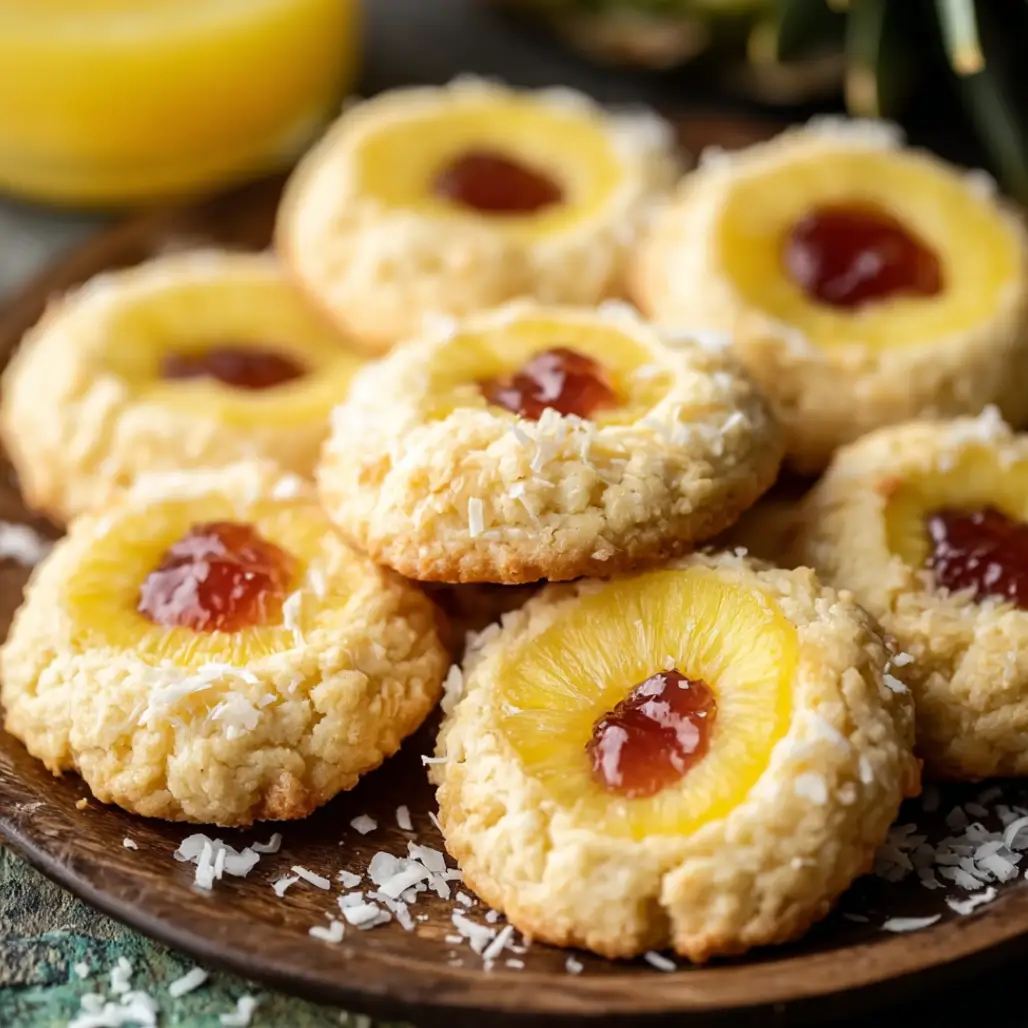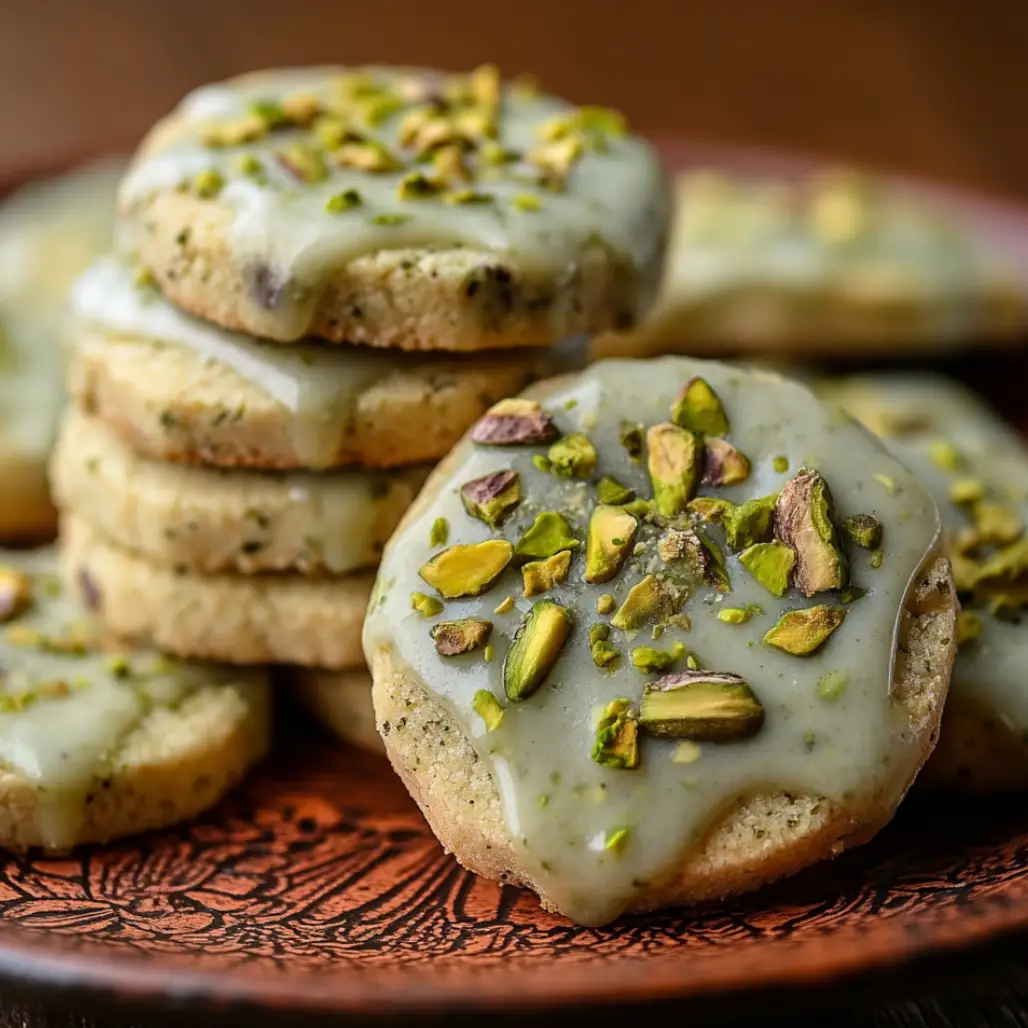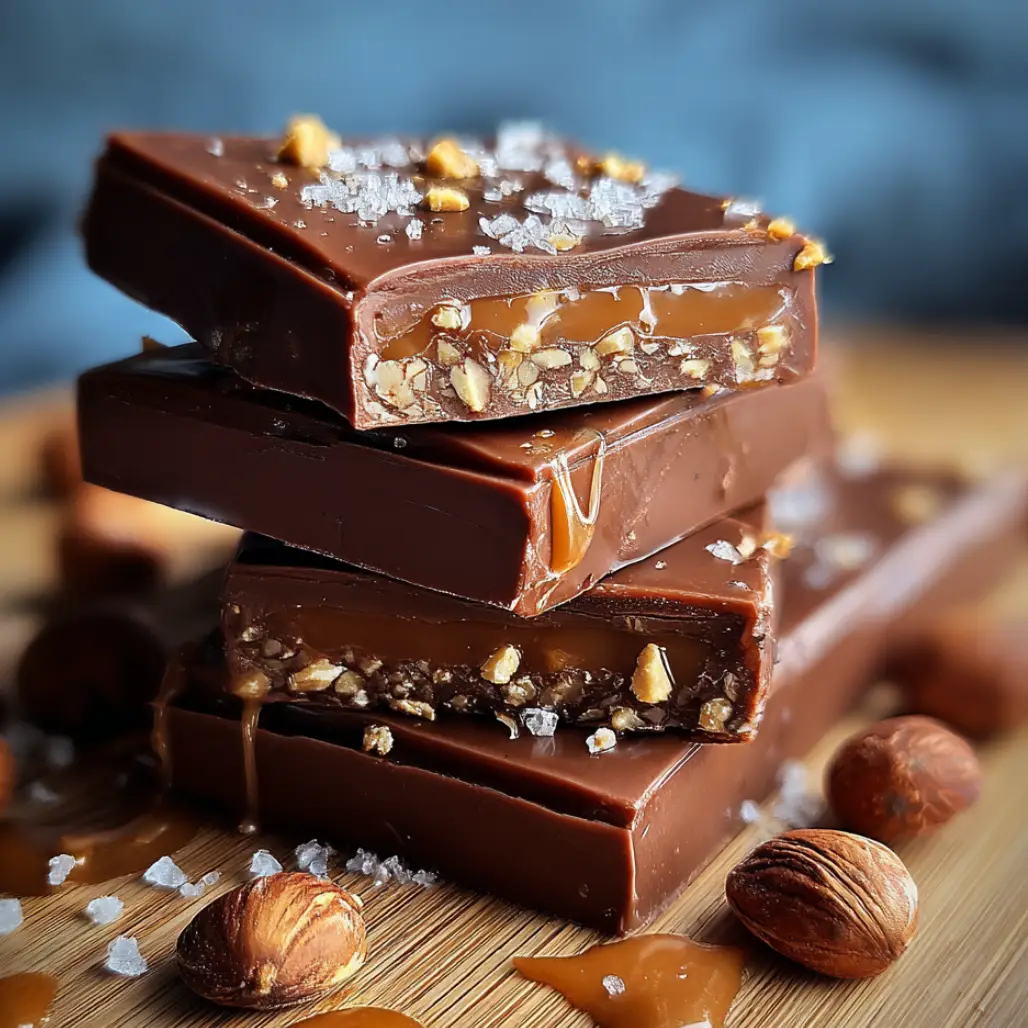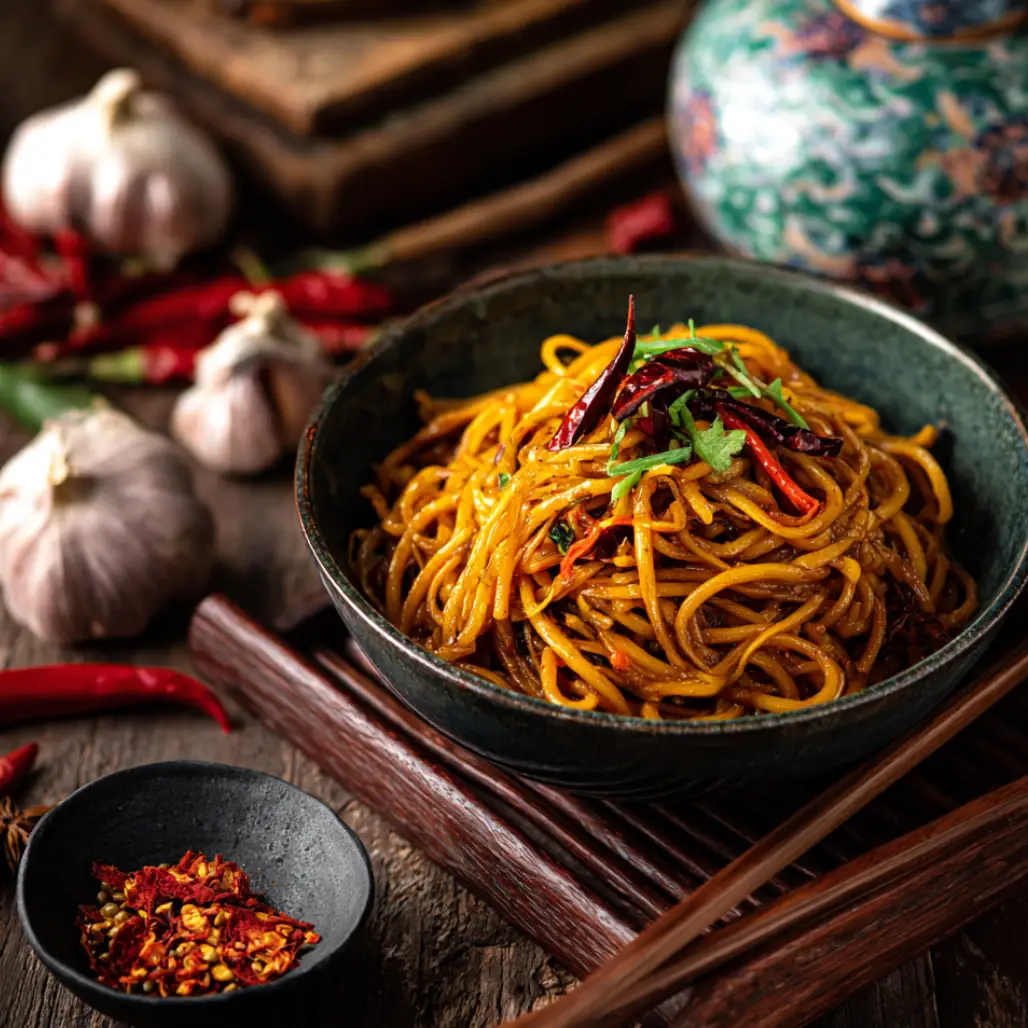| Prep Time: | 5 minutes |
|---|---|
| Cook Time: | 8 minutes |
| :— | :— |
| Total Time: | 13 minutes |
| :— | :— |
| Serves: | 4 |
There’s something absolutely magical about the combination of crispy golden halloumi and the sweet heat of honey infused with chili that creates an irresistible appetizer capable of stealing the spotlight at any gathering because this hot honey halloumi transforms the humble Cypriot cheese into a sophisticated delicacy that balances salty, sweet, and spicy flavors in perfect harmony. The beauty of this dish lies not only in its incredible taste but also in its remarkable simplicity because you can create restaurant-quality results in your own kitchen using just a handful of ingredients and basic cooking techniques that anyone can master.
This recipe delivers crispy edges and a tender, slightly gooey center that makes halloumi so beloved, while the hot honey glaze adds layers of complexity that elevate the cheese from a simple appetizer to an unforgettable culinary experience because the caramelization that occurs during cooking creates deep, rich flavors that complement the cheese’s natural saltiness perfectly.
Why This Hot Honey Halloumi Works
The success of this hot honey halloumi recipe stems from understanding the unique properties of halloumi cheese and how it responds to heat because unlike most cheeses that melt completely when heated, halloumi maintains its structure while developing a beautiful golden crust that provides textural contrast against its creamy interior. The key lies in achieving the perfect balance between the honey’s sweetness and the chili’s heat, creating a glaze that penetrates the cheese surface without overwhelming its natural flavor because halloumi has a distinctive tangy, salty taste that needs complementary rather than competing flavors.
The cooking technique involves two distinct phases that work together to create the ideal texture and flavor profile because first, you sear the halloumi to develop those coveted golden surfaces, then you introduce the hot honey mixture to create a sticky, caramelized coating that adheres beautifully to the cheese. This method ensures that every bite delivers the perfect combination of crispy exterior and tender interior, while the honey glaze provides moisture and flavor depth that transforms simple fried cheese into an extraordinary appetizer experience.
Temperature control throughout the cooking process is crucial because too high heat will burn the honey before the cheese develops proper color, while insufficient heat prevents the caramelization that creates the dish’s signature appearance and flavor because the Maillard reaction that produces those beautiful golden tones requires specific temperature ranges to occur properly.
Essential Ingredients
For the Halloumi:
- 8 ounces halloumi cheese, sliced into 1/2-inch thick rectangles
- 2 tablespoons olive oil for frying
For the Hot Honey Glaze:
- 1/3 cup honey (preferably wildflower or clover)
- 1 teaspoon red pepper flakes
- 2 cloves garlic, minced finely
- 1 tablespoon fresh lemon juice
- 1/2 teaspoon ground black pepper, freshly cracked
- 1/4 teaspoon smoked paprika
- Pinch of sea salt
For Garnish and Serving:
- 2 tablespoons fresh thyme leaves
- 1 tablespoon toasted sesame seeds
- Extra lemon wedges for serving
- Crusty bread or pita chips for accompaniment
The Art of Creating Perfect Hot Honey Halloumi
Mastering this hot honey halloumi requires understanding that each component plays a specific role in the final dish because the cheese provides the protein base and unique texture, while the honey glaze creates the flavor complexity that makes this appetizer so memorable. The quality of your halloumi significantly impacts the final result because authentic Cypriot halloumi delivers superior texture and flavor compared to mass-produced alternatives, so seeking out high-quality cheese from specialty stores or online suppliers ensures the best possible outcome.
Preparing the honey mixture before you begin cooking the cheese is essential because the cooking process moves quickly once you start, and having all components ready prevents the cheese from overcooking while you prepare the glaze because timing is crucial when working with both honey and cheese, as both can go from perfect to burned in a matter of seconds.
The slicing technique affects both cooking time and final presentation because uniform thickness ensures even cooking, while the size of your pieces determines the ratio of crispy surface to creamy interior because smaller pieces provide more surface area for caramelization, while larger pieces showcase the cheese’s texture more prominently. Consider your serving style when deciding on piece size, as smaller portions work better for cocktail parties, while larger pieces make more substantial appetizers for dinner gatherings.
Step-by-Step Instructions
Step 1: Prepare the Halloumi and Workspace Remove the halloumi from its packaging and pat completely dry with paper towels because excess moisture prevents proper browning and can cause dangerous oil splattering when the cheese hits the hot pan. Slice the cheese into rectangles approximately 1/2 inch thick and 2 inches long because this size provides optimal surface area for browning while ensuring the interior heats through properly without becoming rubbery.
Professional Tip: Let the sliced halloumi sit on paper towels for 5 minutes after patting dry because this additional time allows surface moisture to evaporate completely, resulting in better searing and crisping.
Key Points: The cheese should feel completely dry to the touch and hold its shape firmly without any soft or mushy areas that indicate poor quality or improper storage.
Step 2: Create the Hot Honey Mixture Combine honey, red pepper flakes, minced garlic, lemon juice, black pepper, smoked paprika, and sea salt in a small bowl, whisking thoroughly to ensure even distribution of all ingredients because proper mixing prevents hot spots of spice that could overwhelm individual bites. Taste the mixture and adjust seasoning as needed because personal heat tolerance varies widely, and you can always add more spice but cannot remove it once incorporated.
Professional Tip: Warm the honey slightly in the microwave for 10-15 seconds before mixing because warmed honey incorporates other ingredients more easily and creates a smoother, more cohesive glaze that coats the cheese evenly.
Key Points: The mixture should have a balanced sweet-heat profile with no single flavor dominating, and the consistency should be pourable but not too thin to adhere properly to the cheese surface.
Step 3: Heat the Cooking Surface Place a large, heavy-bottomed skillet or cast-iron pan over medium-high heat and add olive oil, swirling to coat the bottom evenly because proper oil distribution prevents sticking and ensures uniform browning across all cheese pieces. Allow the oil to heat until it shimmers but doesn’t smoke because the correct temperature is crucial for achieving golden surfaces without burning the delicate honey glaze that will be added later.
Professional Tip: Test the oil temperature by dropping a small piece of halloumi into the pan because it should sizzle immediately and begin browning within 30 seconds, indicating the perfect temperature for optimal caramelization.
Key Points: The pan should be hot enough to sear the cheese quickly but not so hot that it burns the surface before the interior warms through, creating the ideal texture contrast.
Step 4: Sear the Halloumi to Golden Perfection Place the halloumi pieces in the hot oil, leaving space between each piece to ensure even cooking and prevent steaming because overcrowding the pan lowers the temperature and prevents proper browning that creates the dish’s signature appearance. Cook without moving for 2-3 minutes until the bottom surface develops a deep golden color because premature flipping prevents proper crust formation and can cause the cheese to stick to the pan.
Professional Tip: Resist the urge to move or flip the cheese too early because proper browning requires uninterrupted contact with the hot surface, and you’ll know it’s ready to flip when the edges begin to turn golden and the cheese releases easily from the pan.
Key Points: The first side should be deeply golden with crispy edges before flipping, and the cheese should hold its shape firmly without any signs of melting or losing structure.
Step 5: Complete the Browning Process Flip each piece carefully using a thin spatula and cook the second side for another 2-3 minutes until equally golden because even browning on both sides ensures consistent texture and flavor throughout each piece. The cheese should feel firm but yield slightly to gentle pressure because this indicates proper heating without overcooking that would result in a rubbery texture.
Professional Tip: Look for small bubbles of moisture appearing on the surface of the cheese because this indicates the interior is heating properly and the cheese is developing the ideal tender texture that contrasts beautifully with the crispy exterior.
Key Points: Both sides should be evenly golden with no pale or dark spots that indicate uneven heating, and the cheese should maintain its rectangular shape without splitting or breaking apart.
Step 6: Apply the Hot Honey Glaze Reduce the heat to medium-low and drizzle the prepared hot honey mixture over all pieces of halloumi, using a spoon to distribute evenly because the lower temperature prevents the honey from burning while still allowing it to caramelize properly. Gently tilt the pan to coat all surfaces and allow the mixture to bubble gently for 1-2 minutes because this bubbling action helps the glaze penetrate the cheese surface and create the sticky coating that makes this dish so irresistible.
Professional Tip: Use a silicone brush to spread the glaze evenly across all surfaces if you have one available because this tool allows precise application and ensures every piece receives equal coverage for consistent flavor in every bite.
Key Points: The honey should bubble gently without violent splattering, and the glaze should coat all cheese surfaces evenly, creating a glossy, caramelized appearance that indicates proper caramelization has occurred.
Step 7: Final Caramelization and Plating Continue cooking for another 1-2 minutes, gently turning the pieces to ensure all surfaces are evenly glazed because this final step creates the deep caramelization that gives the dish its distinctive appearance and intensified flavor. Remove from heat when the glaze has thickened slightly and coats the cheese in a glossy layer because overcooking at this stage can cause the honey to burn and become bitter.
Professional Tip: Transfer the hot honey halloumi to serving plates immediately while still warm because the cheese is at its optimal texture when served hot, and the glaze is most appetizing when it’s still glossy and slightly liquid.
Key Points: The finished pieces should be deeply golden with a glossy, caramelized coating that doesn’t drip excessively, and the cheese should feel tender but still hold its shape when gently pressed.
Professional Tips for Success
Quality ingredient selection significantly impacts the final result because authentic halloumi from Cyprus or other Mediterranean sources provides superior texture and flavor compared to mass-produced alternatives that often lack the characteristic squeaky texture and tangy flavor that make halloumi special. When shopping, look for halloumi with minimal ingredients listed on the package because traditional versions contain only milk, salt, and rennet, while heavily processed versions include stabilizers and preservatives that affect both taste and cooking performance.
The honey variety you choose affects both flavor and caramelization properties because different floral sources provide distinct taste profiles that complement the cheese differently, while lighter honeys tend to caramelize more evenly than darker, more robust varieties. Wildflower or clover honey works exceptionally well because they provide sweetness without overwhelming floral notes that might compete with the cheese’s natural flavors.
Timing coordination ensures optimal serving temperature because hot honey halloumi is best enjoyed immediately after cooking when the exterior is crispy and the interior is warm and tender, while cooled halloumi becomes firmer and less appealing in texture. If you’re preparing this dish for guests, consider exploring our snacks appetizers collection for complementary dishes that can be prepared ahead, allowing you to focus on the halloumi’s precise timing requirements.
Creative Variations to Explore
Transform this basic hot honey halloumi into exciting variations by incorporating different spice blends that reflect various culinary traditions because the fundamental technique remains the same while the flavor profiles can transport you to different regions of the world. Mediterranean variations might include oregano, dried mint, and za’atar because these herbs complement the cheese’s Cypriot origins, while Middle Eastern influences could incorporate sumac, dried rose petals, or harissa paste for complex, aromatic heat that pairs beautifully with the honey’s sweetness.
Asian-inspired versions work surprisingly well because ingredients like sesame oil, rice vinegar, and five-spice powder create intriguing fusion flavors that highlight halloumi’s versatility as a canvas for global flavor combinations. Consider adding toasted sesame seeds, scallions, or even a drizzle of sriracha-honey mixture because these elements provide textural interest and visual appeal while maintaining the sweet-heat balance that makes the original recipe so successful.
For those interested in exploring more substantial preparations, this technique works beautifully as part of larger dishes featured in our perfect sides collection, where the hot honey halloumi can serve as a protein component in grain bowls, salads, or flatbread toppings. The versatility of this preparation method allows endless creativity while maintaining the fundamental appeal of perfectly cooked, beautifully glazed cheese.
Perfect Pairing Ideas
This hot honey halloumi pairs exceptionally well with fresh, crisp elements that provide cooling contrast to the sweet heat because the richness of the cheese and honey glaze benefits from acidic or refreshing accompaniments that cleanse the palate between bites. Consider serving alongside cucumber slices, fresh fennel, or crisp lettuce cups because these vegetables provide textural contrast and subtle flavors that won’t compete with the main dish while offering palate-cleansing properties.
Wine pairings should emphasize crisp, acidic whites that cut through the richness while complementing the honey’s sweetness because Sauvignon Blanc, Albariño, or dry Riesling provide the perfect balance of acidity and fruit notes that enhance rather than mask the complex flavors. For beer enthusiasts, light, hoppy IPAs or wheat beers work beautifully because the bitterness balances the sweetness while the carbonation refreshes the palate.
Bread selections should provide sturdy vehicles for the cheese without overwhelming its delicate flavors because crusty sourdough, focaccia, or warm pita offer neutral backdrops that absorb the honey glaze while adding textural interest. You might also explore options from our refreshing beverages collection to find non-alcoholic pairings that complement this rich, flavorful appetizer while keeping your guests refreshed and ready for additional courses.
Discover More Mediterranean Delights
Expand your Mediterranean cooking repertoire by exploring recipes that share similar techniques or ingredient profiles because mastering this hot honey halloumi opens doors to numerous other cheese-based appetizers and main dishes that celebrate the region’s incredible culinary heritage. Grilled feta with herbs, pan-seared kasseri, or baked ricotta with honey all employ similar cooking methods while showcasing different cheese varieties that provide new flavor experiences for your dining table.
The technique of glazing proteins with honey-based sauces translates beautifully to chicken, lamb, or fish preparations because the fundamental principles of caramelization and flavor balance remain consistent across different proteins, allowing you to apply these skills to create complete Mediterranean-inspired meals. Consider exploring traditional mezze preparations that combine multiple small plates because this approach allows you to showcase the hot honey halloumi alongside other complementary dishes.
Our salads collection offers numerous options for incorporating this prepared halloumi into larger dishes because the cheese works beautifully as a protein component in grain salads, roasted vegetable medleys, or fresh herb salads that celebrate seasonal produce. Building these connections between recipes helps you develop confidence in Mediterranean cooking while creating cohesive, restaurant-quality meals at home.
Storage and Make-Ahead Guidelines
While hot honey halloumi is undoubtedly best enjoyed immediately after cooking when the cheese maintains its optimal texture and the glaze retains its glossy appeal, proper storage techniques can help you manage leftovers or prepare components in advance for easier entertaining because understanding how each element behaves over time allows you to plan more effectively. The honey glaze can be prepared up to three days in advance and stored covered in the refrigerator because the flavors actually improve as the spices infuse the honey more completely over time.
Store any leftover cooked halloumi in the refrigerator for up to two days, though the texture will become firmer and less appealing than when freshly prepared because reheating cheese rarely produces results comparable to initial cooking. If you must reheat, use a dry skillet over low heat for just long enough to warm through because excessive reheating will make the cheese rubbery and unpalatable.
For entertaining purposes, you can slice the halloumi and prepare the honey mixture several hours ahead, keeping them separate until cooking time because this preparation strategy allows you to focus on timing the cooking perfectly when guests arrive. The actual cooking process happens so quickly that you can easily prepare this dish while guests watch, creating an interactive element that often becomes a memorable part of the evening because the sizzling and caramelization provide both visual and aromatic entertainment.
The Science Behind Perfect Results
Understanding the scientific principles that make this hot honey halloumi successful empowers you to troubleshoot problems and achieve consistent results because the cooking process involves multiple chemical reactions that require specific conditions to produce optimal outcomes. Halloumi’s unique protein structure allows it to maintain its shape under heat because the way it’s traditionally made creates protein networks that don’t break down at typical cooking temperatures, unlike most cheeses that would melt completely under similar conditions.
The Maillard reaction that creates the beautiful golden color requires adequate heat and protein presence because this chemical process produces hundreds of flavor compounds that give properly cooked halloumi its distinctive taste and aroma. The honey’s role extends beyond sweetness because it contains natural sugars that participate in caramelization reactions when heated, creating complex flavors and the glossy coating that makes this dish so visually appealing.
Temperature control throughout the cooking process affects multiple chemical reactions simultaneously because too high heat can burn the sugars before proper protein browning occurs, while insufficient heat prevents both the Maillard reaction and caramelization from developing properly. This scientific understanding explains why the technique calls for reducing heat when adding the honey mixture because it allows the sugar caramelization to proceed without burning while maintaining enough heat for proper flavor development.
Troubleshooting Common Issues
Even experienced cooks occasionally encounter problems when preparing hot honey halloumi, but understanding the causes helps prevent most issues while providing solutions for those that do occur because many problems stem from technique errors rather than fundamental recipe flaws that can be easily corrected with proper knowledge. If your halloumi doesn’t develop proper golden color, the most likely causes are insufficient heat, excess moisture on the cheese surface, or overcrowding the pan because each of these conditions prevents the high-temperature contact necessary for proper browning.
Burnt honey glaze usually results from adding the mixture to an overly hot pan or cooking too long after application because honey burns at relatively low temperatures compared to the cheese’s browning requirements, which is why the recipe calls for reducing heat before adding the glaze. If this happens, remove from heat immediately and transfer to clean plates because burnt honey becomes bitter and cannot be salvaged, though the cheese underneath may still be perfectly edible.
Rubbery texture in the finished halloumi typically indicates overcooking or using poor-quality cheese because both conditions cause the proteins to tighten excessively, creating an unpleasant chewy texture instead of the desired tender interior. Prevention involves careful heat control and sourcing authentic halloumi from reputable suppliers because quality ingredients combined with proper technique virtually guarantee success, while shortcuts or substitutions often lead to disappointing results that don’t reflect the dish’s true potential.
Additional Mediterranean Inspirations
Build upon your success with this hot honey halloumi by exploring other traditional Mediterranean appetizers that share similar preparation techniques or flavor profiles because mastering one dish often provides the foundation for understanding entire cuisine categories that can expand your cooking repertoire significantly. Spanakopita, dolmades, or grilled octopus all involve techniques that complement what you’ve learned here, while showcasing the incredible diversity of Mediterranean small plates that make for memorable entertaining.
The concept of combining sweet and savory elements appears throughout Mediterranean cuisine because this flavor balance reflects the region’s abundant natural sweetness from fruits and honey combined with the saltiness of coastal ingredients like cheese and olives. Consider exploring our flavored dips marinades collection for accompaniments that would pair beautifully with this halloumi because the right sauce or dip can transform a simple cheese preparation into the centerpiece of an impressive mezze spread.
Traditional mezze service emphasizes variety and balance because multiple small dishes allow diners to experience different flavors, textures, and temperatures throughout the meal, creating a dining experience that’s both social and satisfying. This approach works particularly well for casual entertaining because guests can graze at their own pace while enjoying conversation, and you can prepare many components ahead of time to reduce last-minute stress while still serving impressive, restaurant-quality food that showcases your developing Mediterranean cooking skills.
Conclusion
This hot honey halloumi represents the perfect introduction to Mediterranean appetizer cooking because it combines simple techniques with sophisticated flavors to create a dish that impresses guests while building your confidence in working with specialty ingredients and flavor combinations that define this incredible cuisine. The balance of sweet honey, spicy chili, and salty cheese creates a flavor profile that appeals to diverse palates while the quick cooking time makes it accessible for both weeknight dinners and special occasions because truly great recipes should be versatile enough to fit seamlessly into your regular cooking rotation.
Mastering this recipe provides valuable skills that translate to numerous other Mediterranean dishes because the techniques of proper cheese handling, heat control, and glaze application appear throughout the region’s culinary traditions, making this investment in learning pay dividends far beyond this single preparation. The confidence you’ll gain from successfully executing this hot honey halloumi will encourage you to tackle more ambitious projects because cooking success builds upon itself, creating a positive cycle of experimentation and achievement that transforms occasional cooks into passionate home chefs.
Whether you’re serving this dish as part of an elaborate mezze spread or simply enjoying it as a quick weeknight treat, remember that the best Mediterranean cooking celebrates quality ingredients treated with respect and attention because this philosophy ensures that every bite delivers maximum flavor while honoring the traditions that have made these foods beloved for generations across cultures and continents.

